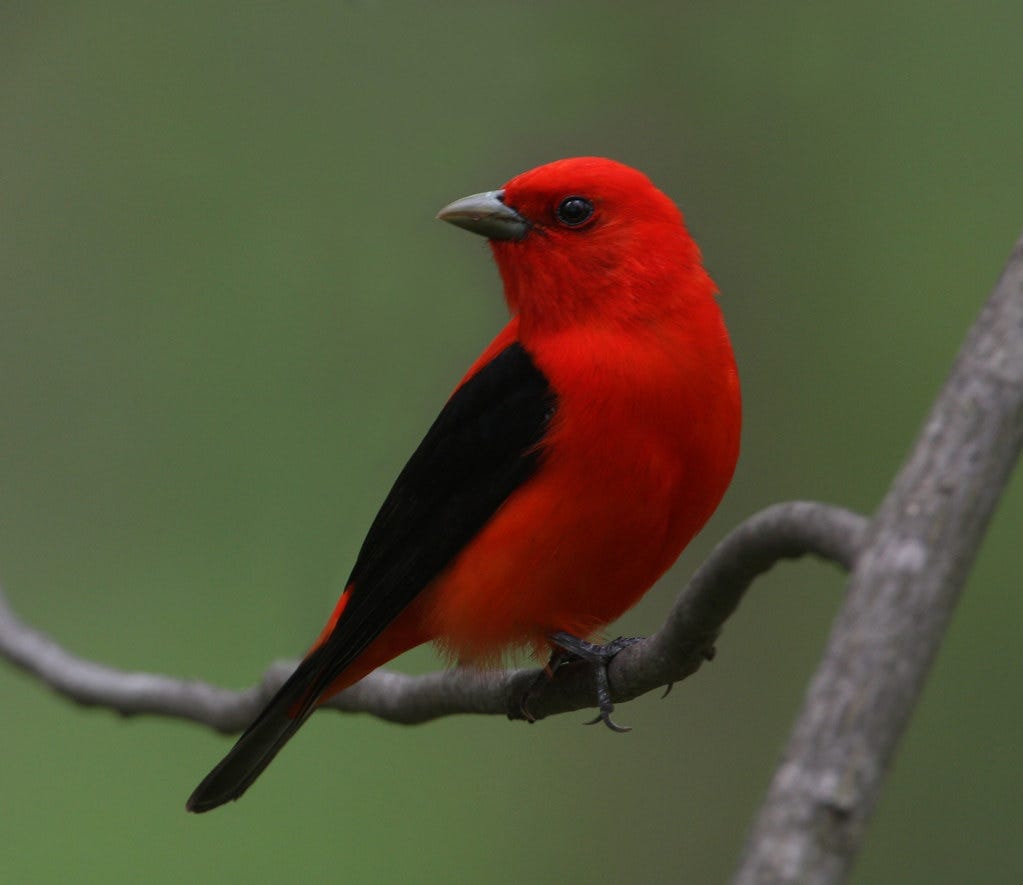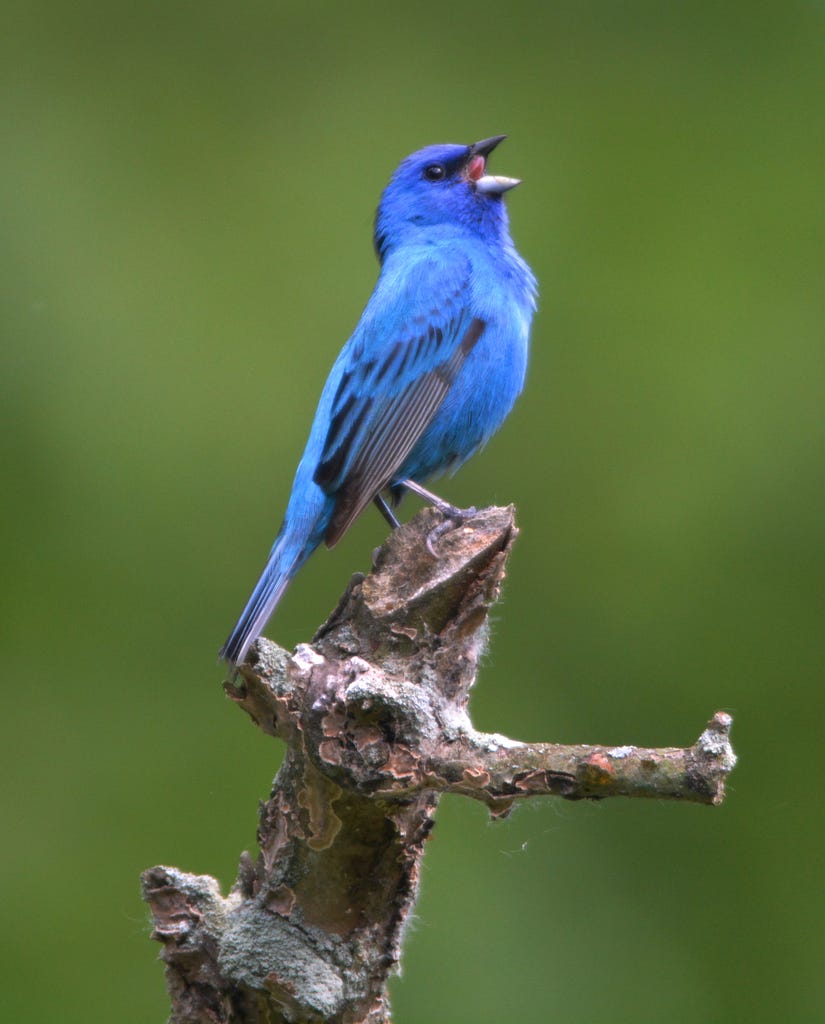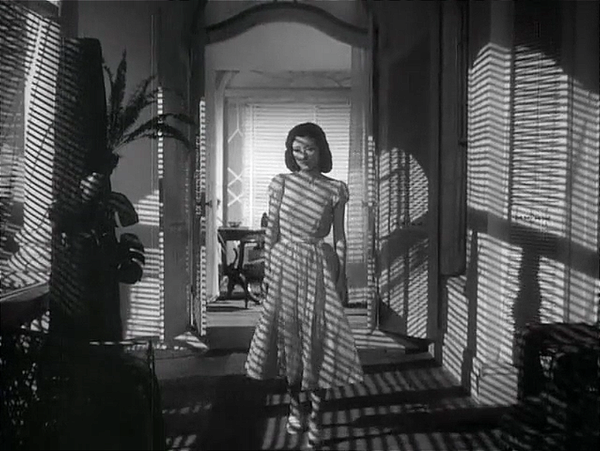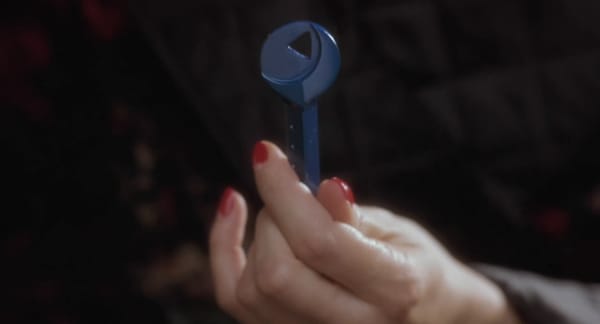Birdsongs of the Anthropocene
Oh Lord, he's writing about birds again.

Hardcore Jim and I roll into the parking lot along the edge of an exurban pond, behind where the state hospital for the insane used to stand, and we open the car doors. This is always the moment of truth: A cacophony of birdsong washes over us as we leave our human travel pod and eject ourselves back into nature. At first it’s pure white noise, two dozen species interweaving their calls into a thick blanket of avian static. And then, if you’ve trained your ears, as Jim has and I’m trying to, the blanket unravels, first into specific kinds of birds and then the individual birds themselves. And then they’re manifest, and you with them. An American Redstart and then this American Redstart. This Scarlet Tanager and, by implication, all Scarlet Tanagers.
It's what I do most mornings in May and June: Get up at an unsainted hour, walk and feed the dog so that my wife can sleep a little later, hop in a car with Hardcore Jim or drive to pick him up, then travel out to a field, or a forest, or a swamp, or a park to check in on the annual spring migration. Among other things, it’s a way to get away from the world by walking further into it, a therapy of presence that allows me to briefly side-step a country I fear is becoming a darker, meaner place than the one in which I grew up (or maybe that’s the naivete of WASP privilege, to think it wasn’t always there). You have your escape – knitting, cooking, rebuilding car engines, collecting porcelain tea sets or Pez dispensers – and I have mine. For me, an Indigo Bunting is both a numbing agent and a corrective, a fellow traveler and a reminder of how little you or I actually matter.

Sometimes Jim and I check out the BirdCast animated radar map from the night before to see what’s come winging in, the flyways over America lighting up with streams of midnight migrants on the move. When we see them in the flesh (the feather?), they’re almost always passing through. A week of Northern Parulas in the bushes telling us to zzzzip-UP, and then they’ve hurried on to Maine and Canada, replaced by Blue-Headed Vireos casually inquiring, “Hey there. How you doing? Yes, you. Why the hat?” (This is my standard transliteration of the bird’s song, which always makes Jim laugh and, if I’m being honest, me too.)
I call him Hardcore Jim because when I met him 30 years ago, he was commuting into Boston by bike during blizzards and skiing blind off mountaintops. He’s a doctor and clinical researcher married to one of my oldest friends, and he’s the kind of person who takes online courses in sparrows. I’ve written about him before. We’re at the age now where I can still hear birdsong at frequencies he no longer can, and he can spot species that I have trouble picking out. He says that between us we have two good ears and close to three eyes.
I like birding with Jim because we don’t have to explain it to each other. It’s a particular past-time, with a reputation for asocial wonkiness perhaps not undeserved, and I was self-conscious about it in my youth. For good reason: One morning when I was around 10, I found a dead bird in the street on my walk to school. I wrapped it up and brought it to my science teacher, an elderly woman who had already sparked in me an interest in looking at the things and who was a ringer for the fusty lady bird expert in Alfred Hitchcock’s “The Birds,” down to the beret and the moustache. (Even her name – Miss Towsey – sounded like something out of a Peterson guide.)
The bird turned out to be a rare vagrant outside its range, was printed up in the local Audubon journal, and a week later I found myself standing before my schoolmates in morning assembly talking about … a Tufted Titmouse. Sweet Jesus, I didn’t make it past the second syllable before hilarity ensued. I didn’t talk much about birds after that. Stopped looking at them, too.
The cure came two decades later, in Manhattan, when I learned that Central Park is perhaps the greatest avian Motel 6 on the planet, an 850-acre rectangle of green amidst 4,700 square miles of Tri-state area cement. Where else are you going to go if you’re a bird? I saw everything, squeezed through the sieve of Manhattan on its way to someplace different. Decades after I’ve moved away, I still follow the Central Park flocks on what is loosely and ironically known as “bird Twitter,” hashtag #birdcpp. It's a way of keeping my hand in.
It's also a pleasant reminder that more people seem to be watching – to be seeing – than ever before. Maybe it’s a hobby born of pandemic boredom, or maybe people are waking up to what we’re so good at killing off. It could be that the creatures are just so weirdly beautiful to look at, little dinosaurs on the fly. I stood in an abandoned apple orchard last week and watched more than fifty Bobolinks launch up and dive down in the tall grass, looking like cosmonauts with their yellow helmets and white epaulets. They’re all males; the females get here a week later, after the guys have chest-bumped each other into separate territories, the meadow staked out in an invisible grid of nests. Have you ever heard a Bobolink? They sound like modems. No, really, they specifically sound like a Hayes modem connecting to America Online in 1996. Could it be possible that the man who invented the modem was a birder? If so, why didn’t he go with the Wood Thrush, whose song is the gentlest and loveliest sound in the forest? Our online discourse might have evolved in radically different directions.
That morning, I shared the Bobolink field with a number of people out with their dogs, they in their loop, I in mine. What did they make of the electronic gibberish erupting from the weeds 10 yards away, the strafing runs, the claiming of turf? For that matter, what do the bobolinks care for us? On another recent outing, Jim and I were birding one of our favorite urban haunts, a pond in a built-up corner of the outer city, when a huge Great Blue Heron reared up and flew across the path directly over the head of a woman walking briskly along with earpods, oblivious to anything but the soundscape in her head. I grumbled at her absorption, but Jim reminded me that everyone deserves their own morning. He’s right, but it’s also true that we humans are extremely skilled at separating ourselves from nature by forgetting we’re part of it. It’s what the Zen Buddhists say about enlightenment: Everyone’s already there, they just don’t know it. But stand long enough listening in a meadow, and you start to dissolve.
If you enjoyed this edition of Ty Burr’s Watch List, please feel free to share it with friends.
If you’re not a paying subscriber and would like to sign up for additional postings and to join the discussions, here’s how:
If you’re already a paying subscriber, I thank you for your generous support.





